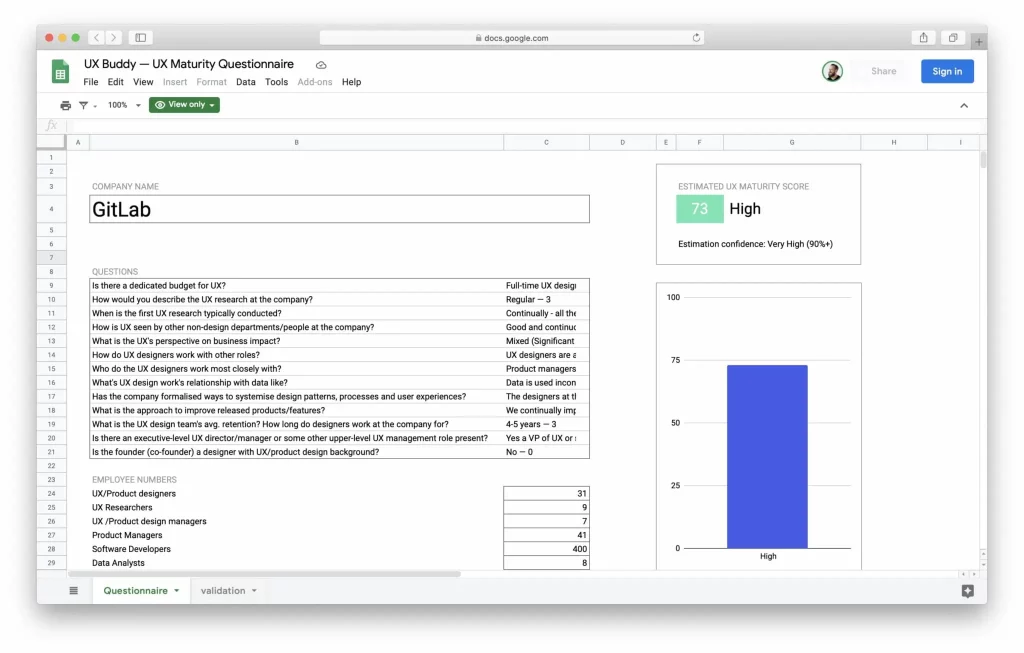I got my first job at 25. I was fresh out of college and really glad to have landed a job at a bank that had its headquarters in my hometown. They later told me that there were more than 150 candidates lined up for it. The salary was very good for the living standards in Slovenia back at the time but I left only 18 months later. I realised that if I wanted to build a career in design I needed to move abroad. So I did.
My new online course UX Buddy helps designers create their UX portfolio, find, and get an awesome UX design job. It’s now live and enrolment is open for a couple more days. Check it out!
I still think of that moment as the key moment in my career. I had freelanced for years before that but I was told that I needed to get a degree and a proper job so that I’ll earn enough money. So I got a degree in economics because there’s no design course at any of the Slovenian universities, and got that high-paying job at the bank. It was a ”proper” job that everyone kept telling me I needed. It wasn’t really a design job either, I was a business process manager. I basically designed software solutions for internal business processes which is very similar to what UX designers do.
Even though it was one of the highest paying jobs someone at 25 could get, my wife and I struggled financially. We had rent and our car to pay off, all that remained of my salary was spent on the living costs and food. The other problem was that I was unhappy at that job. It was a toxic, corporate environment and I felt completely out of place. So I quit to everyone’s surprise and decided to move abroad and give another shot to build a design career even though I was self-taught. Everyone told me that I was crazy to quit such a high-paying and respected job. But looking back now, I realise it spurred the gradual increase of my salary by more than 500% in the 10 years that followed.

I doubled my salary when we moved to Germany to work in a Luxembourgish startup. The costs of living in Germany were the same as in Slovenia so that worked out quite well. We managed to save some money in the two years we spent there. Throughout that time we had our eyes on London because I knew that it was the best place in Europe for a designer to kickstart their career. I doubled my salary again when I started working for a London-based startup. We spent all the savings we had saved up in Germany for that move. Yes, life is expensive in London, but after we settled, my wife and I did well living off of my salary alone for the most time.
I switched jobs 10 months after accepting that first role in London and increased my salary by an additional 20%. After spending three years in London, we realised that it wasn’t a good match for us. So what’s better than a design career in London if you don’t want to move to another continent? The answer is remote work. Getting a remote job was harder but eventually I got an offer to join GitLab. This was the only time that I took a pay cut when switching jobs. We wanted to stay in the UK so we moved to Edinburgh which was less expensive and nicer than London. The thing about GitLab was that the more interviews I had with them, the more I liked the company. So I was happy to lower my salary in return for working in a place where I really fit in.
Here’s the interesting part of this job switch. After one year, my salary at GitLab increased way past the one I had in London. I was doing well and it was recognised by the company. We have yearly performance evaluations at GitLab as well as regular compensation market adjustments which led to more increases of my salary. But the main increases for me came in the first six years through job switches as outlined in the chart above (Fig 1). The first five points on the chart are job switches, the last one is the raise that I got at GitLab.
How designers can increase their salaries
Switch jobs often
You should switch jobs often early in your career for three reasons. The first one is that the more you switch jobs, the more likely it is that you’ll find one that you really like. The second one is tied to the first one because the better match you find the more you’ll enjoy the work. The more you enjoy the work the better your performance will be which will lead to a higher salary. The third reason is that you can use every job switch as an opportunity to get a raise.
Use every job switch as an opportunity to get a raise
I remember how my manager at one of the London-based companies I worked for told me that I was getting a raise:
You’re doing really well, so you’re getting a raise. You’re 3% up which, considering you’ve been with us for only 11 months, is a lot. It’s much more than others usually get.
—My manager at the time
This was in 2017 when the UK’s inflation rate was 2.13%. This means that my raise was actually just 0.87%! After all the work, dedication and enthusiasm I put in. This is no way to acknowledge a worker’s good work. And it’s not even about the money, it is an acknowledgement issue. I was more than happy with the salary I already had at the time, I didn’t need a raise. But this is what it’s like when you stay with some companies. Some don’t even have a performance evaluation programme and a compensation review that would follow it. At some companies employees need to beg and build solid cases for getting a raise.
One of the reasons why I was able to stay with GitLab for so long is their professional, transparent, and adequate approach to compensation adjustments. But that’s because GitLab is a UX mature company and they appreciate designers, equally to all the other employees. Main lesson here is the following: whenever you’re switching jobs always ask for a higher salary. Always, always try to get a raise.
Move abroad or find a remote job
This recommendation is mostly for designers who don’t live in countries where UX and Product design industry is mature. Slovenia is such an example. I knew that if I wanted to work for a company that appreciates and truly understands design, I had to move abroad. That got me so far, but getting a remote job took me further. One of the latest trends in remote work that I started noticing is companies paying US-level salaries to their employees no matter where in the world they are. When it comes to compensation that’s probably the biggest win one can get because you could be earning $180k per year and live in a country with minimal costs of living.
Get a job at a company with high UX maturity
The last recommendation I have for designers to increase their salary is to get a job with a company that is UX mature. For me, that was GitLab. It wasn’t in the highest percentile of UX maturity at the time when I joined but I was experienced enough to recognise that it had the potential. It improved a lot and quickly in the two years after I joined. The thing about UX maturity is that the higher it is, the more the company will appreciate its designers and the better its understanding of design. This leads to better compensation of designers. They’re key employees. They’re not just participants in a process, they define the process. See how to evaluate the UX maturity of a company here and how to use the tool that I built for it (Fig 2).

To get a job at a company with high UX maturity, you’ll need to perform really well in job interviews, have a really solid portfolio, and stand out with your resumé. I can help with that. I wrote an online course to help you do exactly that, it’s called UX Buddy. Registrations are open for one more week, so grab your seat while you can!
Conclusion
Think about it, you could spend ten years of your career working for the same company. Or you could switch jobs ten times in those ten years, each time finding a better match and increasing your salary along the way. The message that I’m trying to get across is the following: job-switching early in the career is good for trying to find a better match and for increasing your salary too. But if you find a really good match, don’t turn it down because of a lower salary. Being happy at work is worth so much more than dollars on your bank account. And don’t switch jobs ten times in ten years, that was just a hypothetical example.

Experience the future of advertising with Fusion Ads 360. Visit our website today and unlock the potential to take your advertising and content efforts to new heights.
I’m really impressed with this salary calculator. It’s accurate, detailed, and easy to use. It’s been very useful in helping me understand my paycheck and plan my finances.
I am a designer with 6 years of experience and a salary of $1,000, working in Russia, I read about salaries in the US and Europe, and it brings tears to my eyes. In Russia, designers have very low salaries.